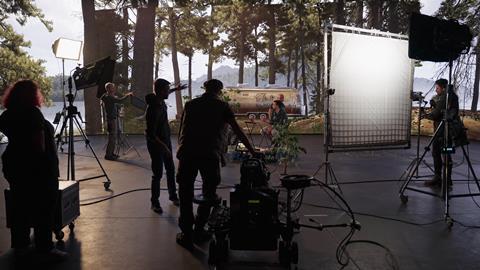Project Arena aims to bring full ray tracing to virtual production

Chaos has announced Project Arena, an effort to bring full ray tracing to virtual production.
Using off-the-shelf Nvidia hardware and ray reconstruction technology, Project Arena aims to help studios quickly move 3D scenes from industry-standard creation tools onto LED screens without a costly/slow data conversion process. Artists can build their assets in software such as Maya, Houdini, or 3ds Max, then bring a V-Ray-authored scene into Project Arena and they are ready to start their virtual shoots - utilising the same assets throughout the process (from pre to post).
It hopes to offer an alternative to gaming engines, such as Unreal Engine, for virtual production.
Project Arena can handle a large amount of geometry, with recent tests seeing a quarter of a trillion polygons running at 60fps on a single GPU, which Chaos hopes to improve with the addition of more shader types. These tests are currently being conducted on virtual production stages around the world while working on a new short that’s being created with Martini Giant’s Daniel Thron and Erick Schiele; cinematographer Richard Crudo; Mesh’s James Blevins; line producer Debbie Kennard and more.
Chaos is now looking for production feedback on Project Arena, and studios apply to take part through its website.
Blevins, co-founder of Mesh and former post-production supervisor of The Mandalorian, said: “Game engines helped kickstart a revolution, but many in the VFX industry still can’t access it. Project Arena takes an essential part of the VFX toolkit, ray tracing, and makes it available in a virtual production volume, straight from Maya, Houdini or 3ds Max. No faking, no baking — just something that puts an artist’s work directly on the wall.”
Crudo, six-term past-president of the American Society of Cinematographers, added: “Project Arena represents a huge step forward for cinematographers by allowing us to do our jobs more creatively, quickly and efficiently. It delivers a much more precise method of accomplishing what up to now has been a generally cumbersome task. My eyes are always the final judge of what I’m doing, and my experience with it thus far has been thoroughly convincing. It’s destined to become the standard for all volume and LED wall work.”
Project Arena has come from the Chaos Innovation Lab, which was designed to accelerate the creation of new tools as well as share research on the likes of offline and real-time rendering, machine learning and AI. It recently announced a number of AI-powered tools it is developing, including text-to-PBR rendering; automated placement of assets in a 3D scene, applying styles to renders, ageing of materials, lighting, and set extension; voice control of software; and an historical asset learner that predicts what users may want next.





No comments yet